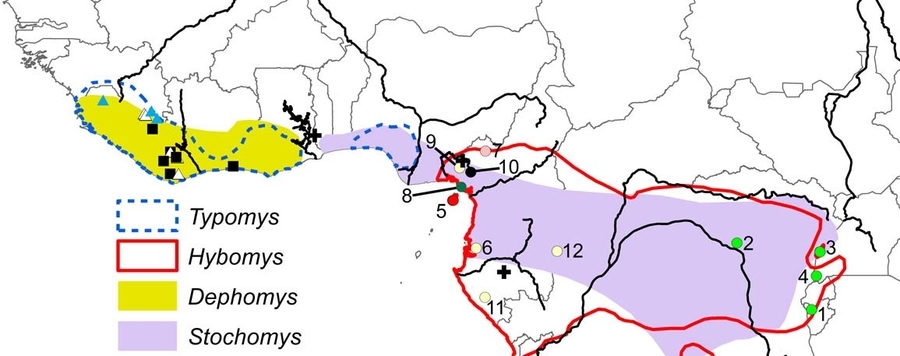
Hybomys zoogeography
The Hybomys division (Muridae: Murinae: Arvicanthini) consists of four genera (Hybomys, Typomys, Dephomys, and Stochomys) endemic to the Guineo-Congolian rainforests of central Africa. Based on sequences from two mitochondrial (Cytb, 12S rRNA) and two nuclear (Rbp3, Ghr) genes, we present a fossil-calibrated molecular phylogeny of the Hybomys division, based on wider taxon and geographic sampling than previously published phylogenies. Species of Typomys formed a clade that was sister to a clade containing Hybomys and the sister genera Dephomys and Stochomys. Hybomys basilii and Hybomys lunaris were recovered as monophyletic, whereas Hybomys univittatus was recovered as polyphyletic and likely consists of at least three species. The divergence between the East African taxon H. lunaris, and the West and Central African taxa of Hybomys is estimated at 3.1 Mya. Based on molecular phylogenies and genetic distances, we infer that forms of Hybomys from both the highlands and lowlands of the Cameroon Volcanic Line, except for H. basilii, should be considered a single species for which Hybomys rufocanus is the oldest available name. As proposed, H. rufocanus would include the named forms badius and eisentrauti as synonyms, as well as populations north of the River Sanaga previously recognized as H. univittatus. Material from nearest the type locality of H. univittatus is sister to H. rufocanus, whereas other specimens currently recognised as H. univittatus from south of the River Ogooue and in the Congo Basin are sister to this H. rufocanus + true H. univittatus clade. Dating estimates place the origin and early diversification of the Hybomys division in the late Miocene, slightly preceding the radiation of most arvicanthine genera that inhabit savannah biomes. The historical biogeography of the Hybomys division appears to be congruent with hypothesized forest refugia, savannah barriers, and aridification cycles of the Neogene and Pleistocene.






